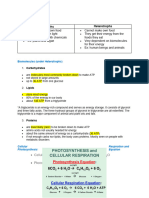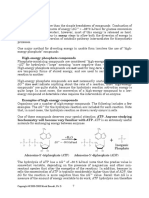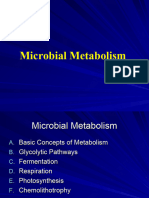0 ratings0% found this document useful (0 votes)
48 viewsBioenergetics: Raymond Oliver A. Cruz
Bioenergetics: Raymond Oliver A. Cruz
Uploaded by
Luigi MendozaBioenergetics is the study of energy transformation in living organisms. It involves the quantitative study of energy transfers between organisms, structures, and cells. These energy transfers are facilitated by chemical reactions and governed by the laws of thermodynamics. ATP plays a central role in bioenergetics by storing and transferring energy from exergonic to endergonic reactions through phosphate group transfers, allowing the coupling of energetically unfavorable reactions. Other nucleoside triphosphates like UTP, GTP, and CTP can also participate in phosphorylations via enzyme-catalyzed transfers.
Copyright:
© All Rights Reserved
Available Formats
Download as PPTX, PDF, TXT or read online from Scribd
Bioenergetics: Raymond Oliver A. Cruz
Bioenergetics: Raymond Oliver A. Cruz
Uploaded by
Luigi Mendoza0 ratings0% found this document useful (0 votes)
48 views30 pagesBioenergetics is the study of energy transformation in living organisms. It involves the quantitative study of energy transfers between organisms, structures, and cells. These energy transfers are facilitated by chemical reactions and governed by the laws of thermodynamics. ATP plays a central role in bioenergetics by storing and transferring energy from exergonic to endergonic reactions through phosphate group transfers, allowing the coupling of energetically unfavorable reactions. Other nucleoside triphosphates like UTP, GTP, and CTP can also participate in phosphorylations via enzyme-catalyzed transfers.
Original Description:
Bioenergetics
Original Title
Bio Energetics
Copyright
© © All Rights Reserved
Available Formats
PPTX, PDF, TXT or read online from Scribd
Share this document
Did you find this document useful?
Is this content inappropriate?
Bioenergetics is the study of energy transformation in living organisms. It involves the quantitative study of energy transfers between organisms, structures, and cells. These energy transfers are facilitated by chemical reactions and governed by the laws of thermodynamics. ATP plays a central role in bioenergetics by storing and transferring energy from exergonic to endergonic reactions through phosphate group transfers, allowing the coupling of energetically unfavorable reactions. Other nucleoside triphosphates like UTP, GTP, and CTP can also participate in phosphorylations via enzyme-catalyzed transfers.
Copyright:
© All Rights Reserved
Available Formats
Download as PPTX, PDF, TXT or read online from Scribd
Download as pptx, pdf, or txt
0 ratings0% found this document useful (0 votes)
48 views30 pagesBioenergetics: Raymond Oliver A. Cruz
Bioenergetics: Raymond Oliver A. Cruz
Uploaded by
Luigi MendozaBioenergetics is the study of energy transformation in living organisms. It involves the quantitative study of energy transfers between organisms, structures, and cells. These energy transfers are facilitated by chemical reactions and governed by the laws of thermodynamics. ATP plays a central role in bioenergetics by storing and transferring energy from exergonic to endergonic reactions through phosphate group transfers, allowing the coupling of energetically unfavorable reactions. Other nucleoside triphosphates like UTP, GTP, and CTP can also participate in phosphorylations via enzyme-catalyzed transfers.
Copyright:
© All Rights Reserved
Available Formats
Download as PPTX, PDF, TXT or read online from Scribd
Download as pptx, pdf, or txt
You are on page 1of 30
BIOENERGETICS
Raymond Oliver A. Cruz
WHAT IS BIOENERGETICS?
Also called biological thermodynamics
(Greek: bios = life and logikos = reason +
Greek: thermos = heat and dynamics =
power)
Bioenergetics is the study of energy
transformation in the biological sciences
More definitively, biological thermodynamics
may be defined as the quantitative study of
the energy transductions that occur in and
between living organisms, structures, and
cells and of the nature and function of the
chemical processes underlying these
transductions.
LAWS OF THERMODYNAMICS
1. The total energy of a system, including its
surroundings, remains constant
2. The total entropy of a system must increase
if a process is to occur simultaneously
Entropy is the extent of disorder or
randomness of the system and becomes
maximum as equilibrium is approached
Change in free energy in biologic
systems
Results in the ability to do work at constant
temperature and pressure
DG=DH-TDS
where DG is the change in free energy
DH is the change in enthalpy (heat)
DS is the change in entropy
T is the absolute temperature in degrees
Kelvin
If DG is negative, the reaction proceeds
spontaneously with loss of free energy
(exergonic reaction)
If DG is of great magnitude, the reaction goes
virtually to completion and is essentially
irreversible
If DG is positive, the reaction proceeds only if
free energy can be gained (endergonic
reaction)
If the magnitude of DG is great, the system is
stable, with little or no tendency for a reaction
to occur
ENDERGONIC PROCESSES PROCEED BY
COUPLING TO EXERGONIC PROCESSES
Autotrophic organisms utilize simple
exergonic processes (plants), such as
obtaining energy from sunlight
Heterotrophic organisms obtain free energy
by coupling their metabolism to the
breakdown of complex organic molecules in
the environment
3 sources of phosphate taking part
in energy conservation
Oxidative phosphorylation (aerobic) –from
respiratory chain using molecular O2 in
mitochondria
Glycolysis – 2 ATP formed from the formation
of lactate from glucose (no oxygen)
Citric acid cycle – 1 ATP
THE ROLE OF ATP
ATP or adenosine triphosphate plays a central role in
the transference of free energy from the exergonic to
the endergonic processes
High energy Ester
Acid anhydride bonds link
The energy is released by cleaving either a
phosphate (Pi) or pyrophosphate (PPi) unit from ATP,
in hydrated conditions:
– ATP + H2O → ADP(hydrated) + Pi(hydrated) + H+
(hydrated)
– ΔG˚ = -30.54 kJ/mol (−7.3 kcal/mol)
– ATP + H2O → AMP(hydrated) + PPi(hydrated) + H+
(hydrated)
– ΔG˚ = -45.6 kJ/mol (−10.9 kcal/mol)
The large release in energy makes the
decomposition of ATP in water extremely
exergonic, and hence useful as a means for
chemically storing energy
Standard Free Energy of Hydrolysis of Some
Organophosphates of Biochemical
Importance
Compound kJ/mol kcal/mol
Phosphoenolpyruvate -61.9 -14.8
Carbamoyl phosphate -51.4 -12.3
1,3-Bisphosphoglycerate (to 3-phosphoglycerate) -49.3 -11.8
Creatine phosphate -43.1 -10.3
ATP AMP + PPi -32.2 -7.7
ATP ADP + Pi -30.5 -7.3
Glucose 1-phosphate -20.9 -5.0
PPi -19.2 -4.6
Fructose 6-phosphate -15.9 -3.8
Glucose 6-phosphate -13.8 -3.3
Glycerol 3-phosphate -9.2 -2.2
LOW ENERGY PHOSPHATES
Ester phosphates found in the intermediates
of glycolysis
Have G values lower than ATP
HIGH ENERGY PHOSPHATES
Act as energy currency of the cell
High-Energy Phosphates Are Designated
by ~ P
The symbol ~ P indicates that the group
attached to the bond, on transfer to an
appropriate acceptor, results in transfer of
the larger quantity of free energy
ATP Allows the Coupling of
Thermodynamically Unfavorable
Reactions to Favorable Ones
The phosphorylation of glucose to glucose 6-
phosphate, the first reaction of glycolysis is
highly endergonic and cannot proceed under
physiologic conditions.
To take place, the first reaction must be
coupled with another—more exergonic—
reaction such as the hydrolysis of the
terminal phosphate of ATP.
When (1) and (2) are coupled in a reaction
catalyzed by hexokinase, phosphorylation of
glucose readily proceeds in a highly
exergonic reaction that under physiologic
conditions is irreversible.
Many "activation" reactions follow this
pattern.
The intermediate location of ATP allows it to
play an important role in energy transfer
When ATP is hydrolyzed to AMP, inorganic
pyrophosphate (PPi) is produced. This
occurs in the activation of long-chain fatty
acids
Other Nucleoside Triphosphates
Participate in the Transfer of High-
Energy Phosphate
By means of the enzyme nucleoside
diphosphate kinase, UTP, GTP, and
CTP can be synthesized from their
diphosphates
All of these triphosphates take part in
phosphorylations in the cell.
Helpful site
https://www.youtube.com/watch?
v=P2WD9jFePwo
You might also like
- MCAT Biology Complete OutlinesDocument34 pagesMCAT Biology Complete OutlinesJacob Mikhail90% (10)
- Spin Operator Dirac ParticleDocument20 pagesSpin Operator Dirac Particlebhuppi KumarNo ratings yet
- 2 Stroke Tuners Handbook by Gordon Jennings 1973Document177 pages2 Stroke Tuners Handbook by Gordon Jennings 1973Steve Darcy50% (2)
- Bioenergetics 2015Document30 pagesBioenergetics 2015Claudette LopezNo ratings yet
- Neuro ThermodynamicsDocument32 pagesNeuro ThermodynamicsNanjit KumarNo ratings yet
- Atp CycleDocument16 pagesAtp CycleDhia Tijani Al ChalishNo ratings yet
- KULIAH BIOKIMIA DASAR - Dr. Chusnul HanimDocument51 pagesKULIAH BIOKIMIA DASAR - Dr. Chusnul HanimMuhammad JuhanNo ratings yet
- Lecture 3Document100 pagesLecture 36002 AJAY KUMAR KNo ratings yet
- Atp and Coupled ReactionDocument3 pagesAtp and Coupled ReactionBhea Mariel CaipangNo ratings yet
- Energy Rich CompoundDocument14 pagesEnergy Rich CompoundSaurav singh SikarwarNo ratings yet
- 100C Study Guide Lect 1-6Document11 pages100C Study Guide Lect 1-6belovedaffectionNo ratings yet
- Bioenergetics and Biological Oxidation FinalDocument27 pagesBioenergetics and Biological Oxidation Finalapi-19859346No ratings yet
- 1st Biochemistry 743Document9 pages1st Biochemistry 743mohmedalrashed447No ratings yet
- Bioenergytic Lec1Document28 pagesBioenergytic Lec1حسن محمد سعيد جاسمNo ratings yet
- Major Metabolic PathwaysDocument11 pagesMajor Metabolic PathwaysDidem KaraNo ratings yet
- S6.CELL RESPIRATION REVISION PAST PAPERS (ecolebooks.com)Document32 pagesS6.CELL RESPIRATION REVISION PAST PAPERS (ecolebooks.com)semukotekaasanasioNo ratings yet
- The Secret Behind The Power of ATP Lies in The Breaking of Chemical Bond Between Second and Third Phosphate Groups. When This Happens, Large Amount of Energy Is ReleasedDocument8 pagesThe Secret Behind The Power of ATP Lies in The Breaking of Chemical Bond Between Second and Third Phosphate Groups. When This Happens, Large Amount of Energy Is ReleasedDimple MontemayorNo ratings yet
- Bio EnergeticsDocument9 pagesBio EnergeticssagarNo ratings yet
- ATP Energy Currency of CellDocument5 pagesATP Energy Currency of CellvachhanikapilNo ratings yet
- Biochemistry SidesDocument13 pagesBiochemistry SidesYousif KashatNo ratings yet
- Bioenergetics Is The Subject of A Field ofDocument21 pagesBioenergetics Is The Subject of A Field ofrksuripeddi517No ratings yet
- Glycolysis:: The Central Pathway of Glucose DegradationDocument23 pagesGlycolysis:: The Central Pathway of Glucose DegradationMohammad Noman AkramNo ratings yet
- 07 Metabolism Basic ConceptDocument76 pages07 Metabolism Basic ConceptfevenNo ratings yet
- Glycolytic PathwayDocument17 pagesGlycolytic PathwayramchinnaNo ratings yet
- GlycolysisDocument46 pagesGlycolysisaishwaryatidke754No ratings yet
- Lectures - Biochemistry 1 - 2021-2022 Prof Version 6.01 - 23-24-141-171Document31 pagesLectures - Biochemistry 1 - 2021-2022 Prof Version 6.01 - 23-24-141-171Ken M'voulaboloNo ratings yet
- Uace Biology Respiration Respiration NotesDocument22 pagesUace Biology Respiration Respiration Notessankata.blasioNo ratings yet
- Energy Transfer in The Body: Presented By: Sneha Shah MPT 1 Year (Neuro)Document32 pagesEnergy Transfer in The Body: Presented By: Sneha Shah MPT 1 Year (Neuro)Vijay ChithraNo ratings yet
- Glycolysis: Net Production of Two Molecules of ATPDocument8 pagesGlycolysis: Net Production of Two Molecules of ATPkarmakarrupsha48No ratings yet
- Chemistry-Viii Notes Prepared by Dr. Dhondiba Vishwanath Suryawanshi, GFGC KR Puram Bengaluru-36Document28 pagesChemistry-Viii Notes Prepared by Dr. Dhondiba Vishwanath Suryawanshi, GFGC KR Puram Bengaluru-36Dr. Dhondiba Vishwanath100% (1)
- Biochem Term PaperDocument8 pagesBiochem Term Paperakanksha awasthiNo ratings yet
- BioenergeticsDocument27 pagesBioenergeticsMuhammad BootaNo ratings yet
- Lecture 20 - ATP and Metabolic Pathways-2Document32 pagesLecture 20 - ATP and Metabolic Pathways-2shiyiNo ratings yet
- Glycolysis: Derived From Greek Words: Glykys Sweet, Lysis SplittingDocument41 pagesGlycolysis: Derived From Greek Words: Glykys Sweet, Lysis SplittingAvinashNo ratings yet
- ATP: Adenosine TriphosphateDocument3 pagesATP: Adenosine TriphosphateClaire ManaoisNo ratings yet
- Glycolysis: Glycolysis (From Glycose, An Older TermDocument22 pagesGlycolysis: Glycolysis (From Glycose, An Older TermChai Hong XuanNo ratings yet
- Explain The Complete Reaction For The Hydrolysis of Adenosine Triphosphat1Document15 pagesExplain The Complete Reaction For The Hydrolysis of Adenosine Triphosphat1NURAIHAN BINTI HASHIM MoeNo ratings yet
- Energy CouplingDocument3 pagesEnergy CouplingHannah VillocenoNo ratings yet
- Cellular RespirationDocument29 pagesCellular RespirationMaxxdlc 16No ratings yet
- Glycolysis Part 3Document12 pagesGlycolysis Part 3Rishav BajoriaNo ratings yet
- GlycolysisDocument12 pagesGlycolysisenrico andrionNo ratings yet
- Reactions MetabolismDocument26 pagesReactions MetabolismEMSARDOUNo ratings yet
- A Level RespirationDocument19 pagesA Level RespirationBWAMBALE HARISONNo ratings yet
- BIOENERGETICS Power Point.Document27 pagesBIOENERGETICS Power Point.abahoareebaNo ratings yet
- Bio EnergeticsDocument8 pagesBio EnergeticsSamuel RookieNo ratings yet
- General Biology (Group 8) How The Hydrolysis of ATP Perform Work ATP HydrolysisDocument2 pagesGeneral Biology (Group 8) How The Hydrolysis of ATP Perform Work ATP HydrolysisClaire MNo ratings yet
- 1 Microbial Metabolism andDocument103 pages1 Microbial Metabolism andcalocetcerphus509No ratings yet
- Metabolic PathwaysDocument69 pagesMetabolic PathwaysShardul DalviNo ratings yet
- RESPIRATIONDocument22 pagesRESPIRATIONkulekennedy1No ratings yet
- Bioenergetics: The Role of ATPDocument12 pagesBioenergetics: The Role of ATPtealempo80No ratings yet
- Atp SynthesisDocument5 pagesAtp Synthesiskman0722No ratings yet
- Lesson 5 Cellular RespirationDocument49 pagesLesson 5 Cellular Respirationauditoree419No ratings yet
- DOC-20241022-WA0028.Document6 pagesDOC-20241022-WA0028.Kyaw Zin ThantNo ratings yet
- Adenosine TriphosphateDocument4 pagesAdenosine TriphosphateFizzah AshfaqNo ratings yet
- OxidatveDocument10 pagesOxidatvehurainsahar21No ratings yet
- Is The Process by Which Chemical Energy in OrganicDocument6 pagesIs The Process by Which Chemical Energy in Organicaiqi2712No ratings yet
- General BiologyDocument3 pagesGeneral Biologyisaylopez794No ratings yet
- High Energy Compouds: Anjali.H.S BCH.10.05.10Document66 pagesHigh Energy Compouds: Anjali.H.S BCH.10.05.10arun231187No ratings yet
- 6.metabolism in FungiDocument67 pages6.metabolism in FungiWahyuni Irmal100% (2)
- high energy phosphate bondDocument12 pageshigh energy phosphate bondsyedabismaahmad8No ratings yet
- Muscles of The Facial Expression (Lab) : OutlineDocument10 pagesMuscles of The Facial Expression (Lab) : OutlineLuigi MendozaNo ratings yet
- Jose Garcia VillaDocument29 pagesJose Garcia VillaLuigi MendozaNo ratings yet
- Temperature, Vibration, Itch, Proprioception - Sense Of: o o o oDocument3 pagesTemperature, Vibration, Itch, Proprioception - Sense Of: o o o oLuigi MendozaNo ratings yet
- ST EP # Reactions Structure Enzymes CofactorsDocument1 pageST EP # Reactions Structure Enzymes CofactorsLuigi MendozaNo ratings yet
- Specific Gravity of Solids and LiquidsDocument4 pagesSpecific Gravity of Solids and LiquidsLuigi MendozaNo ratings yet
- SOP ELISA Edinburgh PDFDocument3 pagesSOP ELISA Edinburgh PDFmofak haesNo ratings yet
- 6 RadioactiveDocument9 pages6 RadioactiveAnna Latifah CammryNo ratings yet
- MetallurgyDocument8 pagesMetallurgyBandita DattaNo ratings yet
- Agar Foam Detection Appl 16Document2 pagesAgar Foam Detection Appl 16JADNo ratings yet
- Polyrock: Product InformationDocument5 pagesPolyrock: Product Informationsattar12345No ratings yet
- Experiment 8 LongDocument5 pagesExperiment 8 LongPeter Hong Leong CheahNo ratings yet
- Experiment 1: Preparation of 2-Iodobenzoic Acid From Anthranilic Acid (2-Amino Benzoic Acid)Document11 pagesExperiment 1: Preparation of 2-Iodobenzoic Acid From Anthranilic Acid (2-Amino Benzoic Acid)Sanjida Khandoker 1911009049No ratings yet
- Physics Question Paper 2015Document3 pagesPhysics Question Paper 2015Arsh GuptaNo ratings yet
- Advertisement No. 1/2019-Rec: (Council of Scientific & Industrial Research)Document7 pagesAdvertisement No. 1/2019-Rec: (Council of Scientific & Industrial Research)Pallavi SharmaNo ratings yet
- Notch and WeirsDocument33 pagesNotch and WeirsAbdur RashidNo ratings yet
- Colorcontin VGPDocument3 pagesColorcontin VGPasebaei95No ratings yet
- 9 X Ray SpectrosDocument24 pages9 X Ray SpectrosDini100% (1)
- Guidelines CNR DT203 2006 EngDocument39 pagesGuidelines CNR DT203 2006 EngAtanasKostadinovNo ratings yet
- Comparison of Horizontal Lip Pressure - R0Document2 pagesComparison of Horizontal Lip Pressure - R0AndiNo ratings yet
- Calibration and Electronic Measurements Unit - IDocument9 pagesCalibration and Electronic Measurements Unit - IPavan KumarNo ratings yet
- Facilities and Environmental Conditions (Linked To Vol. III, Sec. 2) PDFDocument8 pagesFacilities and Environmental Conditions (Linked To Vol. III, Sec. 2) PDFimran shaukat100% (1)
- Entalpia R410ADocument1 pageEntalpia R410Acarlitos_barbosaNo ratings yet
- Mikhail Lomonosov PDFDocument76 pagesMikhail Lomonosov PDFFABIAN FIENGONo ratings yet
- Objective Type MasonryDocument7 pagesObjective Type MasonryPrashant SunagarNo ratings yet
- Acid-Base Tutorial - Kerry BrandisDocument159 pagesAcid-Base Tutorial - Kerry BrandisJason TiongNo ratings yet
- Gatecycle Modeling Exercise PDFDocument50 pagesGatecycle Modeling Exercise PDFHeriyanto Tqn Bin BakriNo ratings yet
- Urea ElectrolysisDocument3 pagesUrea ElectrolysisRichard BrunoNo ratings yet
- Group I (Dilute H SO Group) - CO: (Carbonate), SO (Sulphite), S (Sulphide), NO (Nitrite) : Salt + Dil HDocument4 pagesGroup I (Dilute H SO Group) - CO: (Carbonate), SO (Sulphite), S (Sulphide), NO (Nitrite) : Salt + Dil HSulabh KumarNo ratings yet
- Topic 6 UsingHessLaw Hydration Copper SulphateDocument3 pagesTopic 6 UsingHessLaw Hydration Copper SulphateKeemie PolackNo ratings yet
- Fior Illo 2018Document76 pagesFior Illo 2018Anonymous qmuFcaw13No ratings yet
- LabDocument4 pagesLabapi-2818620680% (1)
- Iso 13715 PDFDocument2 pagesIso 13715 PDFnovkovic1984No ratings yet
- Pneumatics and EPneumatic Results and DiscussionDocument6 pagesPneumatics and EPneumatic Results and DiscussionSyafiq SulaimanNo ratings yet






























































































